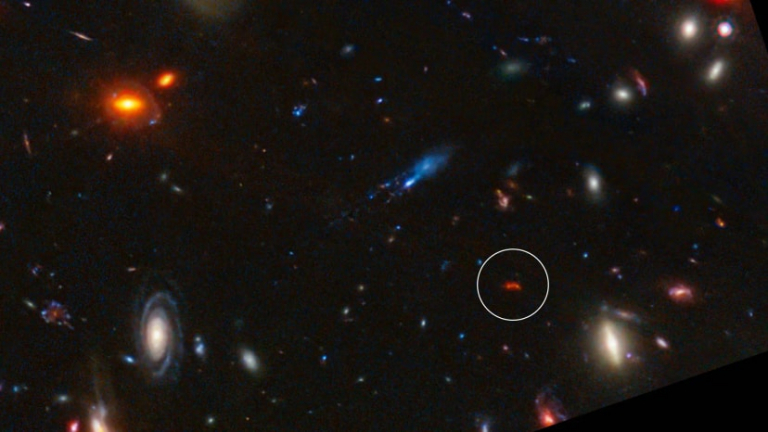Astronomers in the “GBT Observations of TMC-1: Hunting Aromatic Molecules” research survey, known as GOTHAM, have released a spectral line survey with largest amount of telescope time ever conducted, charting more than 100 molecular species only found in deep space.
Recent News
Astronomers Map Mysterious “Dark” Gas in the Milky Way
An international team of astronomers has created the first-ever large-scale maps of a mysterious form of matter, known as CO-dark molecular gas, in one of our Milky Way Galaxy’s most active star-forming neighborhoods, Cygnus X.
Astronomers Spot Magnetically-Guided Streamer Funneling Star-Building Material into Newborn System in Perseus
Using the powerful Atacama Large Millimeter/submillimeter Array (ALMA), their team observed— for the first time ever— a narrow, spiral-shaped streamer of gas guided by magnetic fields, channeling matter from the surrounding cloud of a star-forming region in Perseus, directly onto a newborn binary star system.
Astronomers Discover a Superheated Star Factory in the Early Universe

Astronomers have uncovered a previously unknown, extreme kind of star factory by taking the temperature of a distant galaxy using the ALMA telescope. The galaxy is glowing intensely in superheated cosmic dust while forming stars 180 times faster than our own Milky Way. The discovery indicates how galaxies could have grown quickly when the universe was very young, solving a long-standing puzzle for astronomers.
The first generations of stars formed under conditions very different from anywhere we can see in the nearby universe today. Astronomers are studying these differences using powerful telescopes that can detect galaxies so far away their light has travelled towards us for billions of year.
Now, an international team of astronomers led by Tom Bakx at Chalmers University of Technology in Sweden has measured the temperature of one of the most distant known star factories. The galaxy, known as Y1, is so far away that its light has taken over 13 billion years to reach us.
This research is presented in the paper A warm ultraluminous infrared galaxy just 600 million years after the Big Bang in Monthly Notices of the Royal Astronomical Society, lead author Tom Bakx (Chalmers University of Technology, Sweden).
Read more in this press release from Chalmers University.
About ALMA
The Atacama Large Millimeter/submillimeter Array (ALMA), an international astronomy facility, is a partnership of the European Southern Observatory (ESO), the U.S. National Science Foundation (NSF) and the National Institutes of Natural Sciences (NINS) of Japan in cooperation with the Republic of Chile. ALMA is funded by ESO on behalf of its Member States, by NSF in cooperation with the National Research Council of Canada (NRC) and the National Science and Technology Council (NSTC) in Taiwan and by NINS in cooperation with the Academia Sinica (AS) in Taiwan and the Korea Astronomy and Space Science Institute (KASI).
ALMA construction and operations are led by ESO on behalf of its Member States; by the National Radio Astronomy Observatory (NRAO), managed by Associated Universities, Inc. (AUI), on behalf of North America; and by the National Astronomical Observatory of Japan (NAOJ) on behalf of East Asia. The Joint ALMA Observatory (JAO) provides the unified leadership and management of the construction, commissioning and operation of ALMA.
This news article was originally published on the NRAO website on November 12, 2025.
Recent News
Astronomers Share Largest Molecular Survey To-date: GOTHAM Legacy Data Goes Public
Astronomers in the “GBT Observations of TMC-1: Hunting Aromatic Molecules” research survey, known as GOTHAM, have released a spectral line survey with largest amount of telescope time ever conducted, charting more than 100 molecular species only found in deep space.
Astronomers Map Mysterious “Dark” Gas in the Milky Way
An international team of astronomers has created the first-ever large-scale maps of a mysterious form of matter, known as CO-dark molecular gas, in one of our Milky Way Galaxy’s most active star-forming neighborhoods, Cygnus X.
Astronomers Spot Magnetically-Guided Streamer Funneling Star-Building Material into Newborn System in Perseus
Using the powerful Atacama Large Millimeter/submillimeter Array (ALMA), their team observed— for the first time ever— a narrow, spiral-shaped streamer of gas guided by magnetic fields, channeling matter from the surrounding cloud of a star-forming region in Perseus, directly onto a newborn binary star system.
